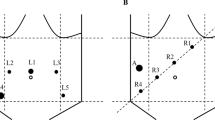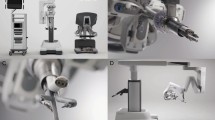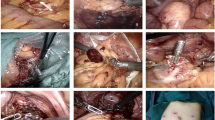Abstract
Background
Sigmoid colon cancer is a lethal disease and has a strong indication for surgery. Robotic-assisted surgery is one of the promising alternative treatment for this disease. Nowadays, the MicroHand S surgical system and the Da Vinci surgical system have been assembled in China. However, there is still no report to study the therapeutic effects of the two robotic-assisted surgical systems. Thus, the purpose of this study was to compare clinical and economic outcomes of patients with sigmoid colon cancer undergoing robot-assisted radical surgery via The MicroHand S or Da Vinci surgical system.
Methods
The clinical data of 45 patients with sigmoid colon cancer undergoing the MicroHand S or Da Vinci robotic-assisted surgery at The Third Xiangya Hospital of Central South University from January 2017 to January 2019 were retrospectively analyzed.
Results
Twenty-one patients received MicroHand S robotic-assisted radical surgery and 24 patients received Da Vinci robot-assisted radical surgery. No significant differences were observed in terms of operation time, number of lymph node harvested, blood loss, intestinal exhaust time, time of oral feeding resumption, volume of abdominal cavity 24-h drainage, hospital stay, complication and rate of conversion, removal time of drainage tube and catheter between MicroHand S and Da Vinci group. However, the MicroHand S group had significantly lower hospitalization costs (P = 0.002) and shorter time to get out of bed after surgery (P = 0.04). In addition, no recurrence and metastases were observed in both groups during the follow-up.
Conclusions
In patients with sigmoid colon cancer, the Da Vinci surgical system did not show obvious clinical advantages compared to the MicroHand S surgical system in surgical outcomes. However, the MicroHand S surgical platform showed advantages in terms of the hospitalization costs and length of postoperative bedtime. The outcome of this study will probably result in a shift to the MicroHand S surgical system as treatment preference in China.

Similar content being viewed by others
References
Wolf A et al (2018) Colorectal cancer screening for average-risk adults: 2018 guideline update from the American Cancer Society. CA Cancer J Clin 68(4):250–281
Pox C, Aretz S, Bischoff SC et al (2013) S3-guideline colorectal cancer version 1.0. Z Für Gastroenterol 51(8):753–854
Jacobs M, Verdeja JC, Goldstein HS (1991) Minimally invasive colon resection (laparoscopic colectomy). Surg Laparosc Endosc Percutaneous Tech 1(3):144–150
Corcione F, Esposito C, Cuccurullo D et al (2005) Advantages and limits of robot-assisted laparoscopic surgery: preliminary experience. Surg Endosc 19(1):117–119
Selby LV, Dematteo RP, Tholey RM et al (2017) Evolving application of minimally invasive cancer operations at a tertiary cancer center. J Surg Oncol 115(4):365–370
Jensen CC, Madoff RD (2016) Value of robotic colorectal surgery. Br J Surg 103(1):12–13
Mak TWC, Lee JFY, Futaba K et al (2014) Robotic surgery for rectal cancer: a systematic review of current practice. World J Gastrointest Oncol 6(6):184–193
Merola S, Wasielewski A, Ballantyne GH et al (2002) Telerobotic-assisted laparoscopic right and sigmoid colectomies for benign disease. Dis Colon Rectum 45(12):1689–1694
Hashizume M, Shimada M, Tomikawa M et al (2002) Early experiences of endoscopic procedures in general surgery assisted by a computer-enhanced surgical system. Surg Endosc Other Interv Tech 16(8):1187–1191
Annibale Annibale D’, Pernazza G, Monsellato I et al (2013) Total mesorectal excision: a comparison of oncological and functional outcomes between robotic and laparoscopic surgery for rectal cancer. Surg Endosc Other Interv Tech 27(6):1887–1895
Yang SX et al (2018) Security and radical assessment in open, laparoscopic, robotic colorectal cancer surgery: a comparative study. Technol Cancer Res Treat. https://doi.org/10.1177/1533033818794160
Kai Shen, Fan Liu, Bin Liang et al (2017) A comparative study of Da Vinci robotic surgery system and laparoscopic treatment of colorectal cancer. Chin J Gen Surg 32(10):813
Tsai KY, Kiu KT, Huang MT et al (2016) The learning carve for laparoscopic colectomy in colorectal cancer at a new regional hospital. Asian J Surg 39(1):34–40
Ljungqvist O, Scott M, Fearon KC (2017) Enhanced recovery after surgery: a review. JAMA Surg 152(3):292–298
Meyer LA, Javier L, Iniesta MD et al (2018) Effect of an enhanced recovery after surgery program on opioid use and patient-reported outcomes. Obstet Gynecol 132(2):281–290
Thorell A, Mac Cormick AD, Awad S et al (2016) Guidelines for perioperative care in bariatric surgery: enhanced recovery after surgery (ERAS) society recommendations. World J Surg 40(9):2065–2083
Fearon KC, Ljungqvist O, Von Meyenfeldt M et al (2005) Enhanced recovery after surgery: a consensus review of clinical care for patients undergoing colonic resection. Clin Nutr 24(3):466–477
Wei Chen, Yajin Chen, Hailong Dong et al (2018) Chinese expert consensus and path management guide for accelerated rehabilitation surgery. Chin J Pract Surg 1:1–20
Gkegkes I, Mamais I, Iavazzo C (2016) Robotics in general surgery: a systematic cost assessment. J Minim Access Surg 13(4):243
Barbash GI, Glied SA (2010) New technology and health care costs-the case of robot-assisted surgery. N Engl J Med 363:701–704
Park JY, Jo MJ, Nam BH et al (2012) Surgical stress after robot-assisted distal gastrectomy and its economic implications. Br J Surg 99:1554–1561
Strong VE, Forde KA, MacFadyen BV et al (2014) Ethical considerations regarding the implementation of new technologies and techniques in surgery. Surg Endosc 28:2272–2276
Kneuertz PJ et al (2019) Hospital cost and clinical effectiveness of robotic-assisted versus video-assisted thoracoscopic and open lobectomy: a propensity score-weighted comparison. J Thorac Cardiovasc Surg 157(5):2018–2026
Iavazzo C, Gkegkes ID (2017) Cost-benefit analysis of robotic surgery in gynaecological oncology. Best Pract Res Clin Obstet Gynaecol 45:7–18
Cleary RK, Mullard AJ, Ferraro J et al (2017) The cost of conversion in robotic and laparoscopic colorectal surgery. Surg Endosc 32(3):1515–1524
Lee YF, Albright J, Akram WM et al (2018) Unplanned robotic-assisted conversion-to-open colorectal surgery is associated with adverse outcomes. J Gastrointest Surg 22(6):1059–1067
Bhama AR, Wafa AM, Ferraro J et al (2016) Comparison of risk factors for unplanned conversion from laparoscopic and robotic to open colorectal surgery using the michigan surgical quality collaborative (MSQC) database. J Gastrointest Surg 20(6):1223–1230
Guend H, Widmar M, Patel S et al (2017) Developing a robotic colorectal cancer surgery program: understanding institutional and individual learning curves. Surg Endosc 31(7):2820–2828
Guohui W, Bo Y, Yong L et al (2019) Clinical phase I study of domestic surgical robots (report of 103 cases). Chin J Pract Surg 39(8):840–843
Funding
This work were supported by the Fundamental Research Funds for the Central Universities of Central South University (2019zzts365) and National Natural Science Foundation of China (81873589).
Author information
Authors and Affiliations
Corresponding author
Ethics declarations
Disclosures
Drs. Dong Luo, Yunfei Liu, Hongwei Zhu, Xia Li, Wenzhe Gao, Xingyu Li, Shaihong Zhu and Xiao Yu have no conflicts of interest or financial ties to disclose.
Additional information
Publisher's Note
Springer Nature remains neutral with regard to jurisdictional claims in published maps and institutional affiliations.
Rights and permissions
About this article
Cite this article
Luo, D., Liu, Y., Zhu, H. et al. The MicroHand S robotic-assisted versus Da Vinci robotic-assisted radical resection for patients with sigmoid colon cancer: a single-center retrospective study. Surg Endosc 34, 3368–3374 (2020). https://doi.org/10.1007/s00464-019-07107-z
Received:
Accepted:
Published:
Issue Date:
DOI: https://doi.org/10.1007/s00464-019-07107-z




